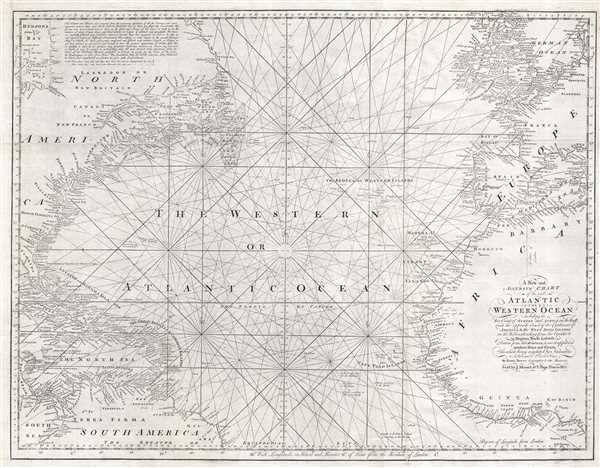This item has been sold, but you can get on the Waitlist to be notified if another example becomes available, or purchase a digital scan.
1778 Mount and Page Nautical Map of the Atlantic Ocean
AtlanticOcean-bowen-1778
Title
1778 (undated) 24 x 31 in (60.96 x 78.74 cm) 1 : 12000000
Description
This map was introduced in the 1778 Mount and Page edition of The English Pilot, The Fourth Book. While inferior to the charts used by British naval officers, this map and its associated volume, were popular with merchant pilots, slavers, smugglers, and pirates active in the trans-Atlantic. Since this chart appeared just after the outbreak of the American Revolutionary War we can safely assume that Bowen recognized the opportunity afforded by the war for an affordable large format chart of the Atlantic. The extant of the chart, reach well into the coastlands of West Africa to the bight of Benin makes apparent its utility to those engaged in underhanded trades.
Bowen derived this map from his own sources but also heavily references earlier French maps, most specifically the 1738 map of the western ocean issued for the Conte du Maurepas and the 1751 map of North America by J. G. B. D'Anville. It was drawn by Emmanuel Bowen and sold by Mount and Page of Tower Hill, London. There were only five subsequent issues of the Fourth Book following the 1778 edition in which this appeared. Not all subsequent editions contained this map and the book had smaller and smaller print runs as it declined in popularity throughout the latter part of the 18th century. Few examples of this map survive today and it rarely appears on the market.
CartographerS
Emanuel Bowen (1694 - May 8, 1767) had the high distinction to be named Royal Mapmaker to both to King George II of England and Louis XV of France. Bowen was born in Talley, Carmarthen, Wales, to a distinguished but not noble family. He apprenticed to Charles Price, Merchant Taylor, from 1709. He was admitted to the Merchant Taylors Livery Company on October 3, 1716, but had been active in London from about 1714. A early as 1726 he was noted as one of the leading London engravers. Bowen is highly regarded for producing some of the largest, most detailed, most accurate and most attractive maps of his era. He is known to have worked with most British cartographic figures of the period including Herman Moll and John Owen. Among his multiple apprentices, the most notable were Thomas Kitchin, Thomas Jeffreys, and John Lodge. Another apprentice, John Oakman (1748 - 1793) who had an affair with and eventually married, Bowen's daughter. Other Bowen apprentices include Thomas Buss, John Pryer, Samuel Lyne, his son Thomas Bowen, and William Fowler. Despite achieving peer respect, renown, and royal patronage, Bowen, like many cartographers, died in poverty. Upon Emanuel Bowen's death, his cartographic work was taken over by his son, Thomas Bowen (1733 - 1790) who also died in poverty. More by this mapmaker...
Mount and Page (fl. 1701 - 1760) was a London based firm of religious and maritime publishers that flourished in the 18th century. With the publication of the 1732 English Pilot, the Mount and Page name became well-known worldwide as an imprint of nautical charts. The firm was founded at Tower Hill, London, in 1701 by Richard Mount (1654 - 1722) and his apprentice Thomas Page (1780 - March 15, 1733). Mount had previously been in partnership with his father-in-law William Fisher (1631 - 1691) and inherited the business on the latter's death. Page completed his apprenticeship in 1716. Now fully partnered, Mount and Page subsequently acquired the map plates several defunct British nautical chart publishers, including Greenville Collins, Jeremiah Seller, Charles Price, and John and Samuel Thornton - thus nearly monopolizing the British nautical chart business. The firm consequently received several lucrative government contracts and thereby flourished throughout the 18th century, making the fortunes of both families. Successive generations of Mounts and Pages worked in the business, and the families intermarried. Its staple titles were The English Pilot and Navigatio Britannica by John Barrow. By the 1760s, Richard Mount's grandson John Mount (1725 - 1786) was able to retire to Berkshire where he built the stately mansion, Wasing Place. John's son William (1753 - 1815) was the last to work in the map business, and later generations went into politics. Learn More...

